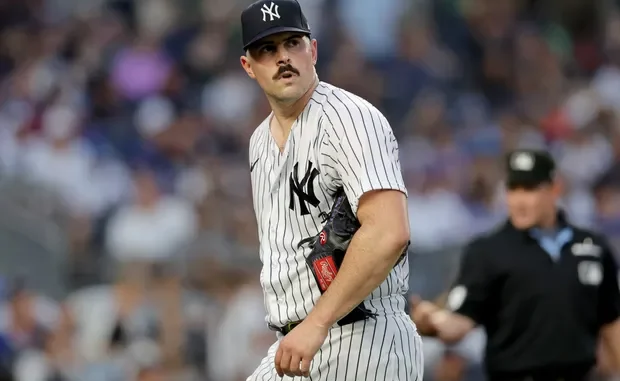
Ugh, I wish I didn’t have to type this. But after his performance on Saturday against the Phillies, we have to ask the question:

How worried should the Yankees be about Carlos Rodón?
I can already hear some of you saying, “Smith, it’s spring training.” And while I’d concur that it’s spring training and we shouldn’t take most of what we see at face value, there are many more indicators pitchers provide in a month than a hitter. Gas is gas, spin is spin, whiffs are whiffs. Not even mentioning last year, Rodón has less gas than at his prime, and that’s shaping up to be a real problem.
On Saturday, Rodón’s fastball — which averaged 95.5 mph in 2022 — was sitting 94.1. That may not seem like a huge drop-off, but the difference can be seen in his whiff rates.
Four-seam fastballs are not a go-to whiff inducer for most pitchers, but they still serve to set up the rest of their arsenal. On Saturday, Rodón produced just two swings and misses against his heater off 26 swings — good for an eight percent whiff rate. This falls well shy of his peak years in 2021 and ‘22, where he posted exceptional four-seam whiff rates of 29.7 and 27.9 percent, respectively:
Rodón’s previous start against the Phillies last Monday was somewhat more encouraging with 5.1 innings of no-hit ball, but that spike in heater whiff rate is a byproduct of him commanding the pitch up in the zone. My point is that the southpaw is suddenly becoming a pitcher who’s far more reliant on commanding his fastball instead of simply overpowering hitters. He’s never had plus command and the velocity he rocked in Chicago and San Francisco seems to be gone. It’s March, but Carlos Rodón seems to have a fastball problem.
Despite this worrisome trend that’s been exacerbated this spring, there is a glimmer of hope. Peter Brody recently wrote about how Rodón seems like a logical candidate to throw a new pitch: a cutter. Rodón’s bread-and-butter pitch is his slider which, though it’s also losing some effectiveness as he throws softer, is still an effective out pitch. The cutter is a perfect hybrid between his heater and slider and the results, while too early to start concluding, have been promising this spring. In an admittedly very small sample size, the cutter has generated whiffs and suppressed hard contact — the exact combo you’d be hoping for.
After never throwing a cutter before 2023, Rodón threw exactly one cutter last year. This spring, it’s become his third pitch, overtaking his change and curve. Cutters are usually included in pitch design for pitchers who have fastball problems. I’m not ready to go there with Rodón quite yet, despite my concerns. Instead, I’ll choose to believe that he’s simply looking for a hybrid pitch between his two primaries that keeps hitters honest. Ideally, Rodón would learn a pitch that tails away from righties because, given his current arsenal, I worry right-handers will feast. Considering his change has never been particularly good, I was hoping we’d hear reports of him tinkering with a splitter. That hasn’t happened, unfortunately.
So, how worried should we be about Carlos Rodón? I think having a fair amount of skepticism is fair at this point. Maybe I’m the Debbie Downer in the community, but it’s a little frightening to consider that Rodón’s season could depend on how successful a brand-new pitch is at limiting hard contact while his two primary pitches continue trending down. You’d hope a pitcher who signed a six-year, $162 million contract barely 12 months ago would have a more certain arsenal. It’s far too early to say this contract is underwater, but we could know the answer to that question by July.
Leave a Reply